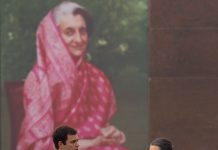The year, 2018, began on a bright note for Preeti Vasudevan, a New York-based dancer and choreographer, with the announcement of the Lincoln Centre Awards for Emerging Artistes. These awards honour the outstanding artistry and promising future of artists from the eleven constituent organisations of Lincoln Center. The line up this year included Preeti, founder and artistic director of her dance company Thresh. Preeti, the first artiste of Indian descent to get this honour is a repeat META (Mahindra Excellence in Theatre Awards) nominee and has multiple awards in her credit.
Linda Murray, Curator at the Jerome Robbins Dance Division of the New York Public library for the Arts, the Lincoln Centre organisation that nominated Preeti, says that their choice was driven by her “deep respect for history, which is important to us as an archive, and also because her creative work is so innovative.” She acknowledges that Preeti’s work “brings Indian classical dance into dialogue with other dance forms, as Preeti seeks parallels and contrasts between her own practice and ballet, postmodern and contemporary dance. She has retained the narrative tradition of Bharatanatyam but has transformed and opened it up by distilling her movements and gestures into a sparse but accessible lexicon. The result is often deeply moving.”
Preeti, who was born in Chennai, lived in Delhi in her formative years and moved to Bangalore by the age of nine and trained there for several years with the iconic gurus US Krishna Rao and his wife Chandrabhaga Devi. Little Preeti soon became their favourite and recalls with affection how her guru used to call her “my little monkey” even while he kept pointing out how talented she was. Their plans for her Ranga Pravesh- the formal debut on the stage as a soloist- were cut short by her father’s relocation to Madras. Her guru advised Preeti to continue her training under the Dhananjayans — VP Dhananjayan and his wife Shanta, both alumni of Kalakshetra and personally trained by none other than Rukmini Devi Arundale.
Here, she caught the eye of Dhanajanyans who created a next-generation duo with her and their son Satyajit. At the India International Dance Festival, held in 1991 in Delhi, she was selected to represent her guru’s style. Seeing the global line up representing styles as varied as Jose Limon and Hanya Holm, “I realised that there was a different world out there for dance,” recalls Preeti sitting on the terrace of her Manhattan apartment in the shadow of the Empire State building.
Although Preeti danced with one Dhanajayan son, Satyajit, but it was the other son, Sanjay, on whom the cupid’s arrows struck upon. Preeti wanted to give herself some space and so accepted a scholarship to go to Japan, which turned out to be an amazing experience for her. She learnt many of the arts Japan is well known for — dance, calligraphy, pottery and even how to wear a kimono. She met with the grand master Kitzu Sakakibara, who had graduated in Indian dance from Visva-Bharati in 1953. “He was like the Uday Shankar of Japan and was happy that I brought him India. I taught the young Japanese students Bharatnatyam, but it was in Japan that I finally learnt how to use my spine.” The last part of the statement may sound odd to non dancers, but a dancer would instantly understand what she meant.
Few days after he returned, she married Sanjay, and went off to Indianapolis on the HB1 spouse visa, as per the rules of which she couldn’t even volunteer. Only after changing her visa to a performing visa, that to from 1995 onwards, she began touring in USA, initially with the Dhanajayans, and then solo. At that time, she also did arts education workshops in juvenile prisons. “It gave me a lot of satisfaction and proved what art can do,” admits Preeti.
Being part of big projects like ‘Jungle Book’ (1996-1997) with her gurus gave Preeti considerable exposure. In 1998, she was the Assistant Director to the Dhanajayans in their new production ‘The Mahabharata’, premiered in the Reunion Island. Armed with the necessary confidence, Preeti choreographed and played the lead role in an English play in Indianapolis- ‘Nagamandal’— her first production in which she danced, choreographed and acted.
In 1998, she was asked by Violette Verdy, famed French ballerina and the legendary choreographer and co-founder of the New York City Ballet, and also George Balanchine’s muse, to dance for the launch of the International Encyclopaedia of Dance edited by Selma Jeanne Cohen. Impressed by her performance, Verdy mentored her. “Her first advice was to relocate to New York City.”
After a mega 28-city tour for the ‘The Mahabharata’ in the US with the Dhananjayans in 1999, which she orchestrated and managed, Preeti “made a millennial transfer to New York and called on people I didn’t know but had heard of — Matteo , the great Spanish dancer who long years ago had learnt Bharatanatyam from Kalashetra and had established the Ethnic Dance Foundation in NY; Jacques d’Amboise, the legendary ballet dancer and muse of Jerome Robbins and Balanchine who since has become a dear friend and mentor to me.”
In 2001, she went on to do her Masters degree in dance from Laban Centre, London, one of the best-known schools for dance studies. Two important developments occurred in this period. The first was that senior dance scholars Valerie Preston and Ana Sanchez Colburg, who have written a book on the Laban process, challenged Preeti
to question and deconstruct her work, compelling her to look at her practice afresh. The second was that she was commissioned to write on the young British dancer from South Asia, Akram Khan who had done the same process and had broken through like a chrysalis and was now a rising star. “At that time I realised that I could not go back to my marriage. Too much was happening around my dance.”
Subsequent to completing her Masters, she moved to New York permanently in 2003. “My thesis from the Laban Centre won me the Emerging Choreographer’s award from Joyce Foundation in NYC. The award was to perform a season in New York. It was a remarkable debut,” she recalls. She was on a roll, with a choreography residency at the American Dance Festival, followed by a faculty position there the very next year. In 2004, Thresh her dance company was established and a highly successful nine city performance tour of India was undertaken.
In 2006, she married again, a British national, Bruno Kavanagh and lived in India for two years, using that time to create an interactive website ‘Dancing for the Gods’ which is used in NYC public schools as a pathway for the students to know Indian culture. She also created a new production based on Kalidas’ ‘Vikramorvashiyam’, called ‘The Absent Lover’, that goes on to win her kudos and many awards, including seven nominations and three awards at META.
There was no looking back after that. She began creating provocative contemporary work from the traditional. Significant among them are ‘Drumming a Dream’ for the Chamber Music Society of Lincoln Centre and ‘Savitri’ for her own company Thresh. In 2013, ‘Savitri’ got nominated to the Meta awards but failed to make the final cut as the jury was divided on whether it was dance or theatre, just the sort of problem one can run into by accepting a fracture between dance and theatre, but stoically Preeti says, “I was happy to be part of a debate.”
She continued on this trajectory with ‘Veiled Moon’ a production commissioned in 2015 by the Metropolitan Museum of Art in New York, which was based on the poetry of Maha Laqa Bai Chanda from the 18th century, a Hyderabad-based Urdu poet, courtesan, philanthropist and the first female poet to have a diwan (collection of poems) of her ghazals and nazms. It was performed as a diptych with William Dalrymple’s talk on the Deccan. In 2015, she became a Certified Movement Analyst from the Laban Institute of Movement Studies, which later conferred her with the Dance Performance Award in the same year.
Most recently, Preeti felt that her work has been driven by the embrace of the ballet world, especially, the mentoring she has received from Jacques d’Amboise. She has worked in a dance collaboration with Amar Ramassar, the principal dancer of the New York City Ballet in a programme called ‘Etudes’. “Etudes was initiated by a prestigious Resident fellowship through the Center for Ballet and the Arts, NYU. The initial work has been performed in many venues, including a week-long residency at the American College of Greece in Athens, but the full evening work is due to be premiered in 2019,” shares an excited Preeti knowing that she is on to something which she didn’t attempt before.
It is not just this path-breaking work but also her recently premiered ‘Stories by Hand’ — a solo work in collaboration with the famous multimedia artist, Paul Kaiser, commissioned through a two-year residency (2015-17) by Bill T Jones’ New York Live Arts, and premiered to great success in November 2017. Preeti Vasudevan is getting noticed as her years of pushing the boundaries are finally bearing the fruit in a demanding city where daring, drive and determination are the first step to success.
letters@tehelka.com













